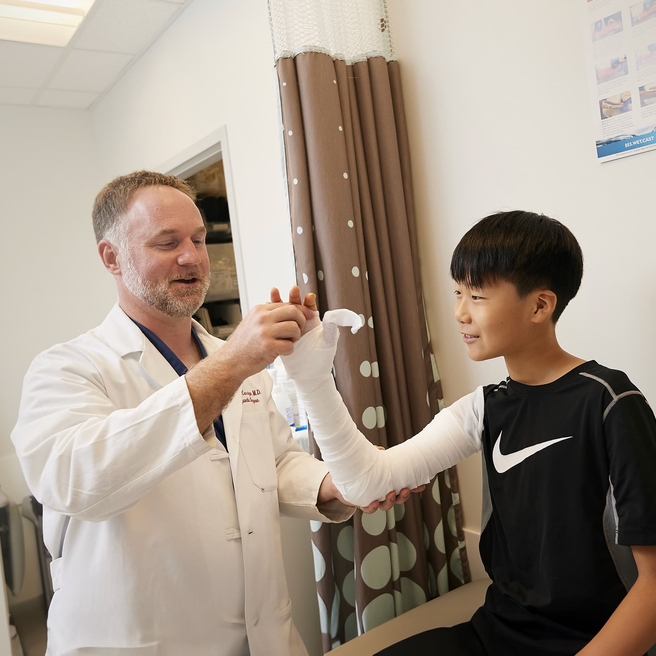What are foot, ankle and toe conditions?
Foot, ankle and toe conditions include all forms of congenital and acquired deformities and injuries to the lower extremities. At Children's Hospital of Philadelphia (CHOP), we diagnose and treat all foot, ankle and toe conditions in children, teens and young adults.
Physicians and surgeons from the Orthopedic Center, Sports Medicine and Performance Center and the Division of Plastic, Reconstructive and Oral Surgery are experts in diagnosing these conditions and creating a customized treatment plan for your child.
Causes
Acquired conditions
Acquired deformities of the foot, ankle and toe may be caused by:
- Trauma (injury) to the growth plate
- Trauma (injury) to joint surfaces
- Fracture malunions
- Neuromuscular deformities (muscular dystrophies, Charcot-Marie Tooth disease, tethered cord, spasticity infection or tumors)
Congenital conditions
Congenital foot, ankle and toe disorders have a genetic cause. While many are evident at birth, some may not become noticeable until adolescence. Other lower extremity disorders are symptoms of complex, multisystem disorders.
Types of disorders
Foot
- Hooked foot: Also called metatarsus adductus, metatarsus varus, metatarsus adductovarus, and SKEW foot, in this disorder the foot is twisted inward in relation to the heel.
- Flatfoot: Also called pes planus, pes valgus, the arch of the foot is absent. There are several forms of flatfoot:
- Flexible flatfoot
- Flexible flatfoot with tight Achilles tendon
- Tarsal coalition, when the joints in the foot or heel fail to properly form during development
- Peroneal spastic flatfoot
- Vertical talus, a severe type of flat foot
- Calcaneovalgus foot: The foot is sharply angled at the heel and pointing upward; in some cases, the top of the foot touches the shinbone
- Accessory navicular: The navicular bone in the center of the foot above the arch collapses
- Cavus foot: A high-arched foot
- Haglund's deformity: A heel bone disorder
- Trevor's syndrome: Also known as epiphysealis dysplasia hemimelica, this disorder affects bone joints and is characterized by overgrowth of the cartilage on the end (epiphysis) of one or more of the long bones (carpal or tarsal bones) in the hand or foot.
Toes
- Hallux valgus and bunions: The great toe overlaps the second toe
- Bunions: Abnormal enlargements of the joint at the base of the great toe; they are the result of inflammation
- Hammer toes: Causes the toe's joints to buckle, cocking the toe upward
- Mallet toe: Causes the joint at the end of the toe to buckle.
- Claw toe: Involves abnormal positions of all three joints of the toe.
- Polydactyly: An extra toe.
- Apert's syndrome: Syndactyly (fusion) of the toes
- Brachydactyly: Congenitally short toes
- Missing toes
Combination disorders
- Osteochondrosis (osteochondritis) dissecans: Affects bone formation in the epiphysis or growing part of the skeleton, and includes:
- Kohler's disease: Occurs when the foot's navicular bone loses its blood supply
- Freiberg's disease: The second metatarsal bone loses blood circulation and dies
- Growth anomalies
- Muscle imbalance deformities
Treatments
Treatment for your child's foot, ankle or toe condition will be based on our expert evaluation and the likelihood for a good outcome. We will work with you and your child to develop an individualized treatment plan.
Treatment may include:
- Bracing
- Casting
- Physical therapy
- Surgery, including:
- Soft tissue and bone reconstruction
- Gradual correction with external fixation (Ilizarov and other external fixation devices.)
Resources to help
Orthopedic Center Resources
We have created resources to help you find answers to your questions and feel more confident in the care you are providing your child.
